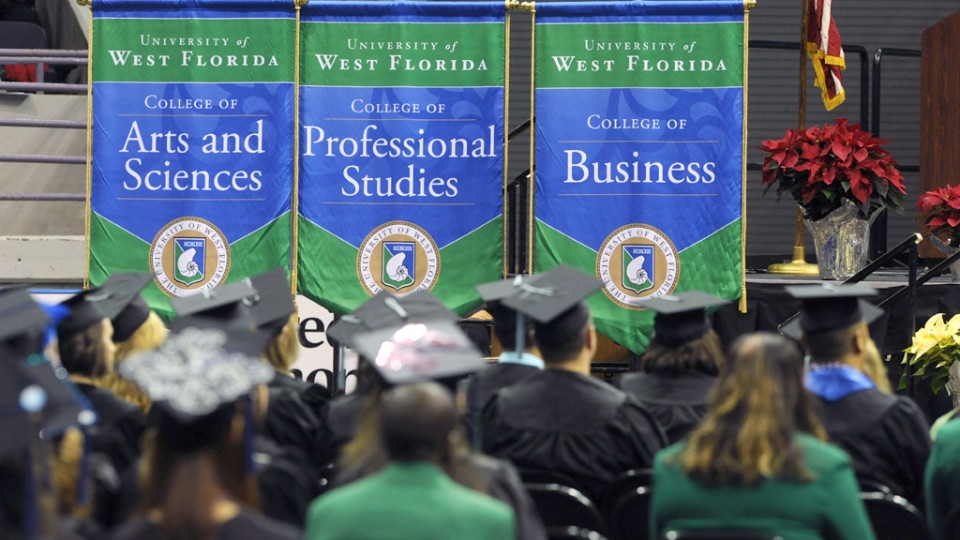Hiring outlook brightening for new college grads
- May 11, 2015
- / Rick Harper
- / education

May is college graduation season, and today’s job market entrants are seeing steadily improving prospects.
Where will those graduates work, and is our recent good job news sustainable?
The Haas Center’s business cycle index for the Pensacola area has shown an accelerating rate of growth for the two years, and labor market performance is the most important component of that index.
For the two-county Pensacola metro, March 2015 jobs were up 4.3 percent over the March 2014 job count. That change of 5,700 was well above the historical rate for our area and reflects both the pickup in job growth throughout the national economy and some special local factors. But the job market is changing and still presents challenges.
In 1990, military and manufacturing jobs made up one-third of all employment in our metro area. That share has dropped to one-fifth of jobs today.
It’s not that we produce less paper or nylon fibers and chemicals, it’s that manufacturing processes generate much more output per employee than they did a generation ago. Similarly, our military missions are increasingly delivered via high-tech processes rather than by boots on the ground. While this productivity growth is good, it means that employment in those sectors is flat or even shrinking.
That downward shift has been more than matched by growth in the shares of education, health care, tourism and financial services. Most recently the jobs numbers suggest that we have become a major exporter of financial services and leisure and hospitality services. However, jobs serving our tourists and retirees are often on the lower rungs of the job ladder.
A rough estimate might be that only a quarter of leisure and hospitality jobs pay above the median wage for our local economy. In contrast, military- and defense- related civilian jobs typically pay well above the median wage.
The challenge for our community is that several of our better-paid sectors are not showing job growth, while several job growth sectors don’t pay well.
Navy Federal Credit Union, however, checks both boxes. Rapid job growth and above-average wages create economic opportunity for thousands of families. Navy Federal has committed to 500 net new jobs per year for the next ten years, and their capital investment at their Heritage Oaks location will reach a billion dollars within the next several years.
To put these large numbers in perspective, consider that average annual growth in jobs on nonfarm payrolls over the 1990–2013 period was 1,400 jobs per year. If we look at 1990–2003 so as to exclude the real estate boom and subsequent bust, job growth averaged 2,000 per year.
Haas Center multiplier models suggest that the creation of a job in Navy Federal is associated with almost 1.2 additional jobs spread throughout the two-county local economy. This means that annual hiring at a pace of 500 jobs per year at Navy Federal would be associated with a total of 1,093 jobs.
The hiring that Navy Federal needs, along with its ripple effects, represents an increase of 78 percent over the historical rate of job creation for Pensacola. That’s a big number.
It appears that good job growth for the metro area is sustainable. It will come from population and business growth, as retirees, tourists, and others do the spending that lets entrepreneurs flourish. We need to double down on the education and training that will enable families to take advantage of new opportunities.
Dr. Rick Harper serves as director of the Studer Community Institute, a Pensacola, Florida-based organization that seeks citizen-powered solutions to challenges the community faces. He also directs the University of West Florida’s Office of Economic Development and Engagement in Pensacola.
 CivicCon launches with a look at good growth in cities
CivicCon launches with a look at good growth in cities
 Building stronger brains one baby, one parent at a time
Building stronger brains one baby, one parent at a time
 SCI debuts commercial on Early Learning City
SCI debuts commercial on Early Learning City
 Entrecon: World class speakers and an opportunity to sharpen skills
Entrecon: World class speakers and an opportunity to sharpen skills
 PYP Quality of Life survey 2017
PYP Quality of Life survey 2017
 EntreCon Pensacola 2016: A look back
EntreCon Pensacola 2016: A look back
 Leadership tip: getting better employee takeaways
Leadership tip: getting better employee takeaways
 Leadership tip: be interested instead of interesting
Leadership tip: be interested instead of interesting
 Leadership tip: delivering difficult messages
Leadership tip: delivering difficult messages
 Brain Bags boost Arc, Early Childhood Court programs
Brain Bags boost Arc, Early Childhood Court programs